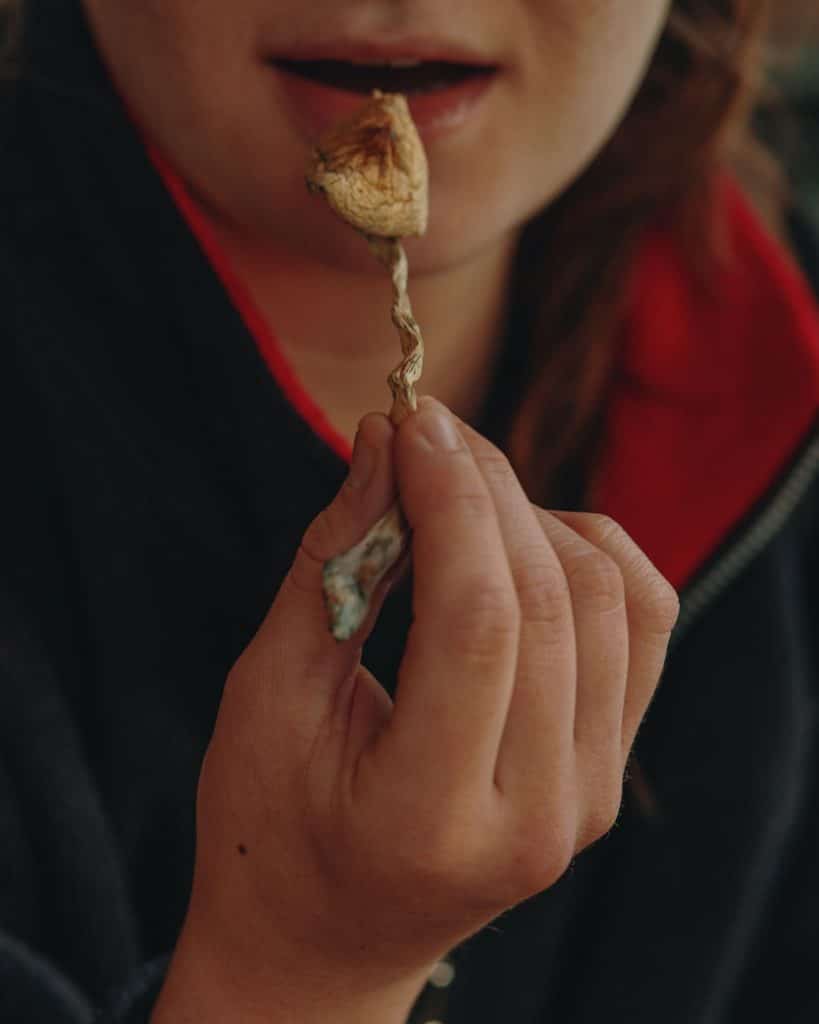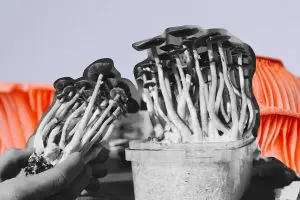The year 1989 marked a turning point in America’s newfound love affair with drug testing. The Drug-Free Workplace Act of 1988 came into effect. That same year, two key Supreme Court cases brought “suspicionless” drug testing into common practice—one of the many War on Drugs era decisions that still affect people today. After 1989, both pre-employment and routine drug screening became commonplace. Employers in the United States continue to drug test more than most other countries.
Mandatory workplace drug tests appear to be on the decline. Yet, many Americans still face suspicionless drug tests, which continue despite recent psychedelic drug decriminalization initiatives and state-by-state cannabis legalization. It’s no surprise then that many, after eating psychedelic shrooms, have concerns: How long do shrooms stay in your system? Can I pass a drug test for shrooms? How do I detox shrooms out of my body? We’ve researched some basic answers.
How Long Do The Effects of Shrooms Last?
The overall psychedelic experience from magic mushrooms can typically last around four to six hours. After ingestion, the beginnings of the psilocybin experience typically kick in after 30 to 40 minutes, although it could take as long as an hour. The overall experience peaks, on average, at hours two to three.
Read: How To Take Shrooms
It’s important to note, however, that the duration of a mushroom trip is highly variable. Many different factors influence the duration and onset of the psychedelic experience, such as the type of mushroom you’ve eaten, your dosage, and how you’ve decided to consume the mushrooms. The duration of a low-dose mushroom trip, for example, can be far shorter than a full trip, potentially lasting only a couple of hours.
Raw vs. Dried Shrooms
Fresh, raw psilocybin mushrooms are more potent than dried mushrooms. This difference means that you need to ingest fewer fresh mushrooms to achieve a psychoactive experience. It also means that you’ll need to eat fewer mushrooms to achieve the standard duration experience, which, as mentioned above, is about six hours.
Tea vs. Edible Shrooms
The way in which you prepare your mushrooms also influences their activation time. Making a mushroom tea may decrease the activation time of the mushrooms, meaning it may take as little as 10 minutes to begin to feel the fungi’s psychedelic effects.
How Long Do Shrooms Stay In Your System?

We’ve got good news: The human body metabolizes magic mushrooms relatively quickly. Researchers estimate that the majority of mushroom metabolites (around two-thirds) leave the human body within the first three hours after consumption. And the rest? Within about 24 hours.
Yet, there are a few caveats—every body is different, after all. Ultimately, how long shrooms stay in your system depends on many different variables, ranging from the type of mushroom you’ve consumed to how well your individual body processes the fungi. Here are a few general factors that may influence both the duration of your trip, as well as how long mushrooms can be detected in your system:
How to Grow Shrooms Bundle
Take Both of Our Courses and Save $90!
- The species of mushroom you’ve eaten
- How many mushrooms you’ve taken
- The way that you’ve consumed mushrooms
- Whether you’ve used raw or dried mushrooms
- Your individual metabolic rate
- Other substances you may have taken at the same time
- Whether you’ve eaten shrooms on a full or empty stomach
How Long Do Shrooms Stay In Urine?
The kidneys do most of the work when it comes to removing mushroom metabolites from the body—and they do it quickly. Research suggests that magic mushroom metabolites are nearly undetectable in urine after 24 hours. Although, it’s important to note that this may not be the case for some individuals. This rate may change significantly for a person with impaired kidney function, for example.
Magic mushrooms contain two primary active compounds: psilocin and psilocybin. The human liver will metabolize psilocybin into psilocin, which is then excreted through urine. Psilocin is also what testing labs check for when analyzing urine for psychedelic mushrooms.
Read: Psilocybin Isn’t the Only Compound in Magic Mushrooms—Here’s What Else There Is
How Long Do Shrooms Stay in Blood?
Most magic mushroom metabolites are filtered and secreted by the kidneys into urine over the six to 12-hour window after you initially consumed magic mushrooms. As such, the detection window in blood and saliva are often too short to be relevant: A blood test or salvia test would need to be administered within mere hours after initial use to find mushroom metabolites in the blood. Remember—potentially up to two-thirds of metabolites are excreted by the healthy kidneys up to three hours after first ingesting the fungi.
How Long Do Shrooms Stay in Hair?
Your hair is a diary of your habits. It holds a record of all that you’ve eaten, what you’ve had to drink, and can tell a surprising amount about your lifestyle. If you’ve eaten magic mushrooms, evidence of mushroom metabolites can show up in your hair for as long as it takes to grow out and to book your next hair appointment. But, the good news? Typically, a hair follicle test will check for the presence of shrooms in hair over the previous 90 days. So, there’s potentially no need to worry if you have long hair and tried some shrooms a year ago. Keep reading for more information on shrooms and hair follicle tests below.
Do Drug Tests Check for Shrooms?
If you’ve recently taken shrooms and are facing a surprise drug test, you just might be in luck—the two most common urine tests do not check for psilocin. However, mushroom metabolites will show up on a test for hallucinogens, although these tests just aren’t performed as frequently.
Urine testing, called urinalysis, is the most common type of drug test. Uranalysis is often used for both pre-employment screenings as well as for routine workplace drug testing. They can also be used by welfare offices, probation offices, and other institutions. Of urine tests, the five-panel test is the most common—and it doesn’t test for magic mushroom metabolites.
Instead, the dreaded urinalysis tests for other common substances, like cannabis, amphetamines, opiates, cocaine, and PCP. Sometimes, however, someone will request a more comprehensive drug test. In that case, the nine-panel drug test is perhaps the most common. The nine-panel test often adds barbiturates, benzodiazepines, methadone, and quaaludes to the mix—still not psilocin.
Less common still are 10, 11, and 12-panel urinalysis. Yet, even these panels generally do not include tests for psychedelic drugs like LSD, DMT, and psilocybin. Instead, these drug tests typically target additional amphetamines like MDMA and painkillers, like oxycontin. A test for psilocin and other hallucinogenic drugs would need to be ordered separately, which is expensive and relatively uncommon in the world of drug testing.
What About A Hallucinogen Drug Test?
Most employment-related urine tests do not test for the presence of hallucinogens. But, that doesn’t mean that being tested for a psychedelic isn’t possible; if there is reasonable suspicion that you have used a psychedelic, then an employer is technically within their legal right to order a drug test, even if you used psychedelics on your personal time. Tests for specific hallucinogens can also be mandated as a qualification of parole, for some safety-oriented jobs, or another matter.
The most common way to test for the presence of magic mushrooms is a special-ordered urine test, which checks for the presence of psilocin. Other hallucinogenic drug tests may check for LSD, mescaline, and peyote. These tests, however, are not in common use. Neither are blood nor saliva tests for hallucinogens.
Shrooms and Hair Follicle Tests
The standard hair analysis for drug use analyzes hair over a 90-day detection period—and yes, shrooms will show up if they are being tested for. During a hair follicle test, a technician will collect hair samples on the crown of the head. Usually, the technician will collect around 100 to 120 hairs from various spots around the crown of the head. Laboratory technicians will then analyze portions of the air that were closest to the scalp.
The good news? Mushroom metabolites and other psychedelics are not often tested for in a hair follicle test. Like a urine test, most hair follicle tests look for a standard panel of substances. The most common substances checked for in a hair follicle test are cannabis, opiates, amphetamines, PCP, and cocaine. Of course, someone can certainly order tests that check for the past use of psychedelics.
Hair follicle drug tests are also more uncommon than urine tests, the latter being the primary way employers test for drug use. Nevertheless, employers, probation offices, courts, and other entities still order them. A hair follicle test is more often used for checking patterns of drug use over time, which may be relevant for those recovering from addiction or involved in drug treatment. Hair follicle testing may also be used in various types of legal cases.
How To Pass A Drug Test For Shrooms

As the old abstinence advice goes, the only way to pass a drug test for shrooms is to not take them in the first place. This is especially true for hair follicle tests, which can be very difficult to pass if you’ve consumed any sort of illicit substance. As a result, many desperate consumers take to the internet and engage in potentially risky practices like washing their hair with laundry detergent, shaving their heads, bleaching hair, and purchasing expensive detox shampoos that may not do the trick, anyway. When a consumer has a lot at stake, these methods may seem like lifesavers. But, there are never any guarantees—it’s just really difficult to wash away the chronological record that’s stored in hair.
Uranalysis is a bit of a different story. Like hair testing, there is no way to guarantee that you’ll pass a drug test for shrooms if you take the test shortly after consuming them. Unlike hair testing, there is perhaps more light at the end of the tunnel with urinalysis. Mushroom metabolites are water-soluble, meaning that staying hydrated and drinking plenty of fluids may support your body in removing shrooms from your system. Yet, whether you drink water or not, there are no guarantees.
How to Detox Shrooms from your System
If you’ve just ingested shrooms and would like to detox them from your system, the best advice is this: Get to a calm and safe environment and call a trusted person or medical professional for help. Once you’ve eaten shrooms, it’s not entirely possible to stop a trip in its tracks. Taking activated charcoal within one hour after you ingested the shrooms may be helpful, although its overall effectiveness is uncertain. As is sipping fluids, which may help you urinate, although certainly won’t speed up your body’s metabolism.
Apart from seeking medical attention, finding a safe and quiet place to ride out the remainder of the trip with a trusted friend is recommended. Soothing activities like listening to calming music, looking at plants or nature, or distracting yourself with some artwork may help you cope with the experience. Keep in mind that while the psilocybin experience can be quite intense, it is not permanent. The entire psychedelic experience will be over in about six hours. Call Fireside, a psychedelic peer support line, if you feel unsafe or if you’re concerned about a friend’s reaction to the mushrooms.
This article is intended for educational and harm reduction purposes. It is not intended to promote illicit activity.
Interested in having a psychedelic experience, but don't know where to start? Get our definitive guide on trusted legal retreat centers, clinical trials, therapists, and more.



